2017 goes down as costliest year for weather disasters ever recorded in US
A catastrophic weather season resulted in a record-setting toll on the United States in 2017, with 16 billion-dollar weather and climate events costing a total of $306 billion in damage.
These events included one drought event, two flooding events, one freeze event, eight severe storm events, three tropical cyclone events and one wildfire event.
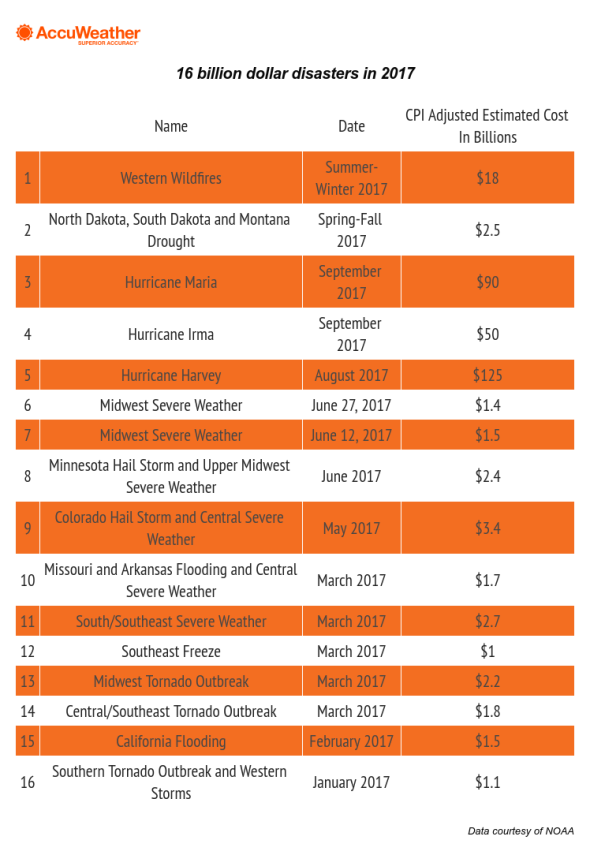
The cumulative damage of these 16 U.S. events during 2017 is $306.2 billion, which shatters the previous U.S. annual record cost of $214.8 billion (CPI-adjusted), established in 2005 due to the impacts of hurricanes Dennis, Katrina, Rita and Wilma.
2017 also landed in the record books for being the third warmest year on record for the U.S.
The extreme weather has taken a toll on people physically, economically and emotionally.
The effect is perhaps clearest in terms of property damage in the United States' territories as well as in the states, with governments, insurers and individuals counting up the losses from torn-apart homes, flooded cars, downed bridges and destroyed electrical grids and hospitals.
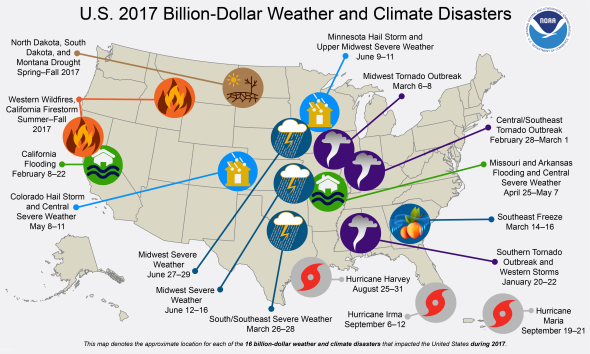
AccuWeather accurately predicted the severity of 2017 hurricanes, emphasizing the devastating and costly effects of Harvey, Irma and Maria before the storms struck.
"The 2017 hurricane season is the costliest hurricane season in U.S. history in terms of money," AccuWeather Chief Operating Officer Evan Myers said.
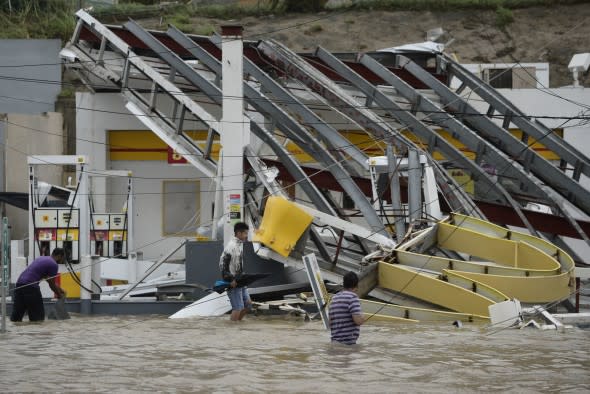
People walk next to a gas station flooded and damaged by the impact of Hurricane Maria, which hit the eastern region of the island, in Humacao, Puerto Rico. (AP Photo/Carlos Giusti)
Certain factors allowed the hurricanes to reach their maximum potential strength and maintain or increase that strength as they made landfall.
"Harvey, Irma and Maria all took advantage of warmer-than-normal sea surface temperatures along the path they took, and all three tracked through very favorable atmospheric environments that featured lower-than-normal vertical wind shear, lower-than-normal surface pressure and deep moist air," AccuWeather Hurricane Expert Dan Kottlowski said.
Vertical wind shear, or the change of wind speed and direction with altitude, can limit the development of tropical systems, according to Kottlowski.
When wind shear is not present, a tropical cyclone's center will be vertically aligned, which keeps it intact and allows it to strengthen. However, when upper-level winds come over top of a system, they can tilt the system in one direction and make it harder for the system to intensify further, Kottlowski explained.
Hurricanes Harvey, Irma and Maria seemed to maintain strength or increase in strength as they blasted into land. The mainland United States had never been hit by two hurricanes with Category 4 strength in the same season during the course of recorded history, as was the case this year with Irma and Harvey.
Also notable was the fact that both Irma and Maria maintained their intensity over such a long period of time. Irma maintained 185-mph winds for three days straight, which is longer than any tropical cyclone ever recorded around the globe.
Maria plowed over United States territories in the Caribbean, including the U.S. Virgin Islands and Puerto Rico, with cataclysmic fury.
"...I observed 130-mph-plus winds over the Virgin Islands for at least three hours. No wonder all vegetation, especially trees, were blown over across most of these islands," Kottlowski said.
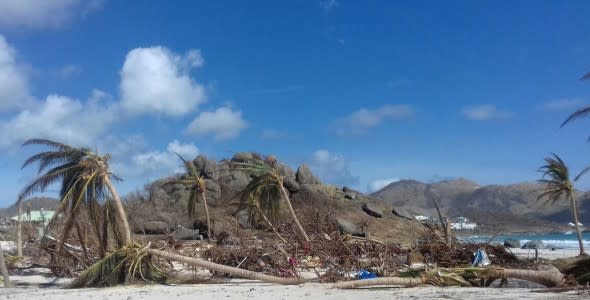
Damaged palm fronds lay on Baie Orientale beach, after the passing of Hurricane Irma, in Saint Martin. (AP Photo/Amandine Ascensio)
Kottlowski said it will take decades for some of these islands to have the lush vegetation that it once had before the hurricanes hit.
"Statistically, the 2018 hurricane season will be less destructive. We have never seen back-to-back seasons of this kind of destruction," Kottlowski said.
However, Kottlowski said current projected information for next season suggests the 2018 hurricane season will be another active one with the number of named storms, hurricanes and major hurricanes expected to be higher than normal.
"Where these storms track will determine the severity of the destruction. That's something we can't forecast this far out," Kottlowski said.
In 2017, California residents faced a devastating fire season. The Thomas Fire, which was California's largest wildfire in recorded history, destroyed block after block of homes as cars were melted down to skeletal remains.
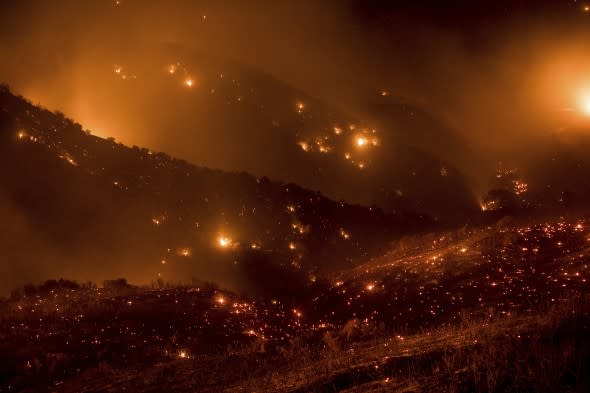
A hillside glows with embers as the Thomas fire burns through Los Padres National Forest near Ojai, Calif., on Friday, Dec. 8, 2017. (AP Photo/Noah Berger)
"The cost to contain and fight the fire and deal with the aftermath will be in the billions," Dr. Joel N. Myers, president and founder of AccuWeather, said.
"The loss in tax revenue from businesses no longer around, including the vineyards, the workers who have lost their jobs and can no longer pay taxes as well as other impacts will be quite costly. This will create a hole in the California budget, which may necessitate an increase in taxes. If California has to borrow more, this might negatively impact its bond ratings and it will have to pay higher interest rates on all borrowings," Myers said.
The main reason for such a devastating fire season was a wetter-than-normal winter preceding dry summer weather.
"Winter precipitation promotes abundant growth of new vegetation in spring. This vegetation, however, rarely makes it to fall without curing due to California's hot, dry summers, so abundant fuels were available for wildfires," AccuWeather Meteorologist Evan Duffey said.
"Then as fall came around, long-lasting high pressure systems to the east provided the opportunity for offshore wind events which often lead to or worsen fire activity," Duffey said.
Quiz Maker - powered by Riddle
